Lords of Poverty
I’ve just finished Graham Hancock‘s 1989 classic “Lords of Poverty” and recommend it to anybody interested in the working of the international aid bureaucracy. Hancock is scathing in his assessment of international aid agencies such as the United Nations, bilateral aid agencies (eg US AID), development banks (eg World Bank), and the IMF, and concludes that they haven’t just made a few unfortunate mistakes but they are irredeemably broken and need to be abandoned.
I found a few of his examples to be overly harsh, but found his thesis to be generally persuasive. Instead of trying to review his themes, I think it best to provide some extended quotes, and then encourage you to read the rest…
“This is how the game works: public money levied in taxes from the poor of the rich countries is transferred in the form of ‘foreign aid’ to the rich in the poor countries; the rich in the poor countries then hand it back for safe-keeping to the rich in the rich countries. The real trick, throughout this cycle of expropriation, is to maintain the pretence that it is the poor in poor countries who are being helped all along. The winner is the player who manages to keep a straight face while building up a billion-dollar bank account”
…..
“At $60 billion a year [in 1989]… aid is already quite large enough to do harm. Indeed, as this book has argued at some length, it is often profoundly dangerous to the poor and inimical to their interests: it has financed the creation of monstrous projects that, at vast expense, have devastated the environment and ruined lives; it has supported and legitimised brutal tyrannies; it has facilitated the emergence of fantastical and Byzantine bureaucracies staffed by legions of self-serving hypocrites; it has sapped the initiative, creativity and enterprise of ordinary people and substituted the superficial and irrelevant glitz of imported advice; it has sucked potential entrepreneurs and intellectuals in the developing countries into non-productive administrative activities; it has created a ‘moral tone’ in international affairs that denies the hard task of wealth creation and that substitutes easy handouts for the rigours of self-help; in addition, throughout the Third World, it has allowed the dead grip of imposed officialdom to suppress popular choice and individual freedom.
“Aid has its defenders, not least the highly paid public-relations men and women who spend millions of dollars a year justifying the continued existence of the agencies that employ them. Such professional communicators must reject out of hand the obvious conclusions of this book: that aid is a waste of time and money ,that its results are fundamentally bad, and that — far from being increased — it should be stopped forthwith before more damage is done.
“Whenever such suggestions are made the lobbyists throw up their hands in horror. Despite some regrettable failures, they protect, aid is justified by its successes; despite some glitches and problems, it is essentially something that works; most important of all — the emotional touch, the appeal to the heartstrings — they argue with passion that aid must not be stopped because the poor could not survive without it. The Brandt Commission provided a classic example of this line of thought: ‘For the poorest countries,’ it told us flatly in its final report, ‘aid is essential to survival.’
“Such statements, however, patronise and undervalue the people of the poor countries concerned. They are, in addition, logically indefensible when uttered by those who also want us to believe that ‘aid works’. Through history and pre-history all countries everywhere got by perfectly well without any aid at all. Furthermore, in the 1950s they got by with much less aid than they did, for example, in the 1970s — and were apparently none the worse for the experience. Now, suddenly, at the tail end of almost fifty years of development assistance, we are told that large numbers of these same countries have lost the ability to survive a moment longer unless they continue to receive ever-larger amounts of aid. If this is indeed the case — and if the only measurable impact of all these decades of development has been to turn tenacious survivors into helpless dependents — then it seems to me to be beyond dispute that aid does not work.
“On the other hand, if the statement that ‘aid works’ is true, then presumably the poor should be in a much better shape than they were before they first began to receive it half a century ago. If so, then aid’s job should by now be nearly over and it ought to be possible to begin a gradual withdrawal without hurting anyone.
“Of course, the ugly reality is that most poor people in most poor countries most of the time never receive or even make contact with aid in any tangible shape or form: whether is it present or absent, increased or decreased, are thus issues that are simply irrelevant to the ways in which they conduct their daily lives. After the multi-billion-dollar ‘financial flows’ involved have been shaken through the sieve of over-priced and irrelevant goods that must be bought in the donor countries, filtered again in the deep pockets of hundreds of thousands of foreign experts and aid agency staff, skimmed off by dishonest commission agents, and stolen by corrupt Ministers and Presidents, there is really very little left to go around. This little, furthermore, is then used thoughtlessly, or maliciously, or irresponsibly by those in power — who have no mandate from the poor, who do not consult with them and who are utterly indifferent to their fate. Small wonder, then, that the effects of aid are so often vicious and destructive for the most vulnerable members of human society.”
That ends the polite and optimistic part of the book. The rest is a disappointing story of repeated mismanagement, incompetence, bureaucracy, waste, and corruption. I fear that Hancock is right when he concludes that the problem is institutional. It is too easy for people to conclude that the system can work if only it is repeated enough times with “good people” instead of “bad people”, but the truth is that sometimes the institutional arrangement just doesn’t work.
I would argue that the key institutional problems relate to incentives and knowledge. There is nothing wrong with the concept of helping people, but before good intentions can become good outcomes you need to ensure that the institutions are such that people face the right incentives and knowledge can be effectively coordinated. Most of the sad stories in Hancock’s book are examples of people responding rationally to warped incentives, or people failing to effectively use available knowledge.
This is an echo of the same institutional debates that happened 100 years ago regarding business, where Hayek convincingly argued that a voluntary system will tend to provide better incentives and use of knowledge compared with a bureaucratic system. In hindsight it is clear that Hayek was right and that private business generally out-performs government business. A similar debate is now needed in the “social” sector, where we need to consider whether a voluntary civil society (including mutual societies, charities, extended families and social business) might provide a better institutional framework compared to the ever-growing (but seemingly ever-failing) welfare and aid bureaucracy.










